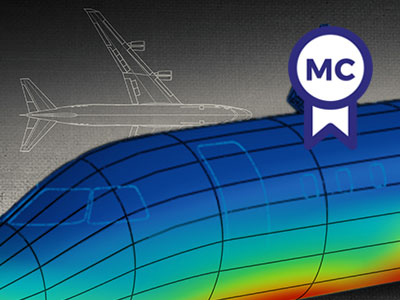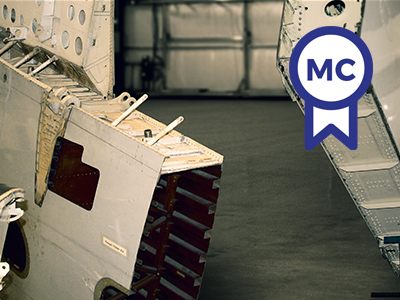Overview
The interaction between structural dynamics and unsteady aerodynamic flow over the structure, with focus on aircraft design.
Aeroelasticity is the investigation of the interactions between structural dynamics and the unsteady aerodynamic airflow over the structure. This area is becoming increasingly important, especially for the design of next-generation aircraft: the interaction between structures and aerodynamics has a significant influence on the design and weight of the airframe as well as its aerodynamic performance.
This is an essential topic for engineers for two main reasons. First, the interaction can lead to static or dynamic instabilities which can result in failure of the structure. Secondly, the loads calculated using aeroelastic simulations are significantly different for flexible structures compared to decoupled structural and aerodynamic simulations.
This course explores the most important aeroelastic phenomena and will be of value to professionals working in the design and production of aircraft and helicopter components, wind turbine and other aerodynamic structures. For students of aerodynamics this course will advance their knowledge and understanding of aeroelastic phenomena and their effect.
In this course you will learn:
- about the physical processes which drive aeroelastic phenomena
- to formulate and solve aeroelastic response and instability problems
- to identify strengths and weaknesses of different aerodynamic and structural models for the analysis of a given aeroelastic condition
- to be familiar with the role of aeroelasticity in aircraft design
- to be able to carry out aeroelastic calculations using software
Quote on this course
"My best experience with online studies so far was the online Aeroelasticity course at TU Delft. All lectures were given in an easy-to-follow manner, in bite-size chunks that help you to plan your study time conveniently. It made it easy to go through the content and to go back and review topics that required more effort to grasp. The contact with the lecturer was fast, personal and useful – was especially helpful when I could not figure how the computer program interpreted data and how tiny mistakes skewed the results. It was also great to discuss those issues on the discussion forum, where all learners could share their results and way of working." - Roger Coenen
Earn a Microcredential with this course
A Microcredential is an additional quality certification for small educational units. It shows what knowledge, competence and experience the participant has gained upon successful completion of the course. A Microcredential is awarded in the form of a digital badge which can be shared and is instantly verifiable.
This certification is awarded to participants who enroll and complete the course starting on November 13, 2023 or later.
More information
Details
The course will introduce you to the basic principles of aeroelasticity. The most important aeroelastic phenomena for aircraft and wind turbine design are explored with an examination of how they affect structural and aerodynamic performance. Finally you have to make use of commercial and custom software to apply aeroelasticity in project analysis and design.
The breakdown of the course is:
- introduction to aeroelasticity and aeroelastic phenomena
- illustration of aeroelastic phenomena using simplified aerodynamic and structural models
- subsonic and supersonic aerodynamic models for aeroelastic analysis
- structural models for aeroelastic analysis
- aeroelastic response to arbitrary excitation
- aeroelastic models in state-space format
- introduction to nonlinear aeroelasticity
- introduction to aeroelastic control
- aeroelastic aspects in the design of aircraft
- numerical aeroelastic calculations using software
Literature and Study Materials
Additional references (optional):
1. J.R. Wright and J.E. Cooper, "Introduction to Aircraft Aeroelasticity and Loads", Wiley, 2007
2. E.H. Dowell (Editor), "A Modern Course in Aeroelasticity", 4th edition, Kluwer Academic Publishers, 2004
3. C.S. Bisplinghoff, H.Ashley, R.L.Halfman, "Aeroelasticity", Adisson-Wesley Publishing Company, 1955
4. Y.C. Fung, "An introduction to the theory of aeroelasticity", Dover Publications Inc., New-York, 1955.
Assessment
Assignment and oral exam (via Skype).
Qualifications
Certification
If you successfully complete your online course you will be awarded with a TU Delft certificate.
This certificate will state that you were registered as a non-degree-seeking student at TU Delft and successfully completed the course. The certificate will also indicate the number of ECTS credits this course is equal to (3 ECTS) when this course is taken as part of a degree program at the university.
This course is a MSc course in the Faculty of Aerospace Engineering. If you decide that you would like to apply to the full Master's program in Aerospace Engineering, you will need to go through the admission process as a regular MSc student. If you are admitted, you can then request an exemption for this course that you completed as a non-degree-seeking student. The Board of Examiners will evaluate your request and will decide whether or not you are exempted.
Chartered Engineering Competences
All our online courses and programs have been matched to the competences determined by KIVI’s Competence Structure, a common frame of reference for everyone, across all disciplines, levels and roles.
These competences apply to this course:
- A1: Extend your theoretical knowledge of new and advancing technologies.
Admission
Below, you can find the expected prior knowledge required to participate in this course. Please note that these are provided as indications only. TU Delft will not request proof of this prior knowledge through copies of degrees or diplomas. However, it is your responsibility to ensure that you possess the necessary knowledge, acquired through prior education or relevant work experience.
- A relevant BEng or BSc degree in a subject closely related to the content of the course or specialized program in question, such as aerospace engineering, aeronautical engineering, mechanical engineering, civil engineering or (applied) physics.
- The learning objectives of the following TU Delft courses:
- Level of English equivalent to one of the following certificates:
- TOEFL score 90+ (this is an internet-based test)
- IELTS (academic version) overall Band score of at least 6.5
- University of Cambridge: "Certificate of Proficiency in English" or "Certificate in Advanced English"
Admission process
In order to complete your admission process you will be asked to upload a valid copy of your passport or ID card.
Contact
If you have any questions about this course or the TU Delft online learning environment, please visit our Help & Support page.


